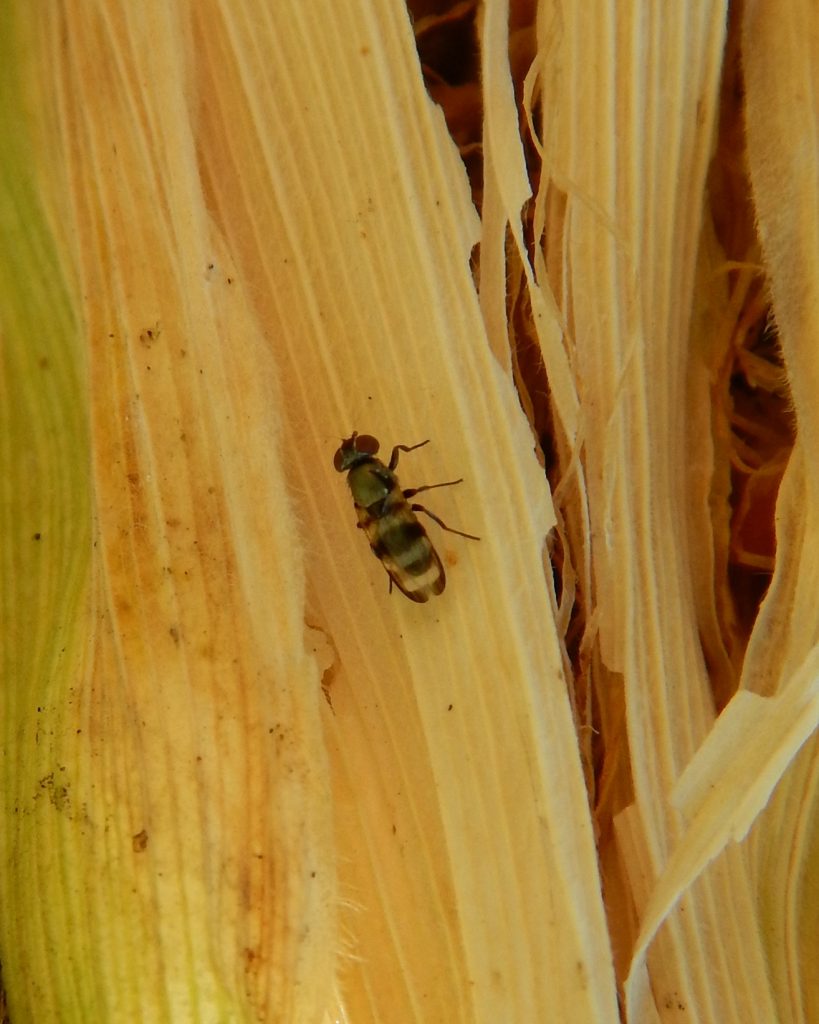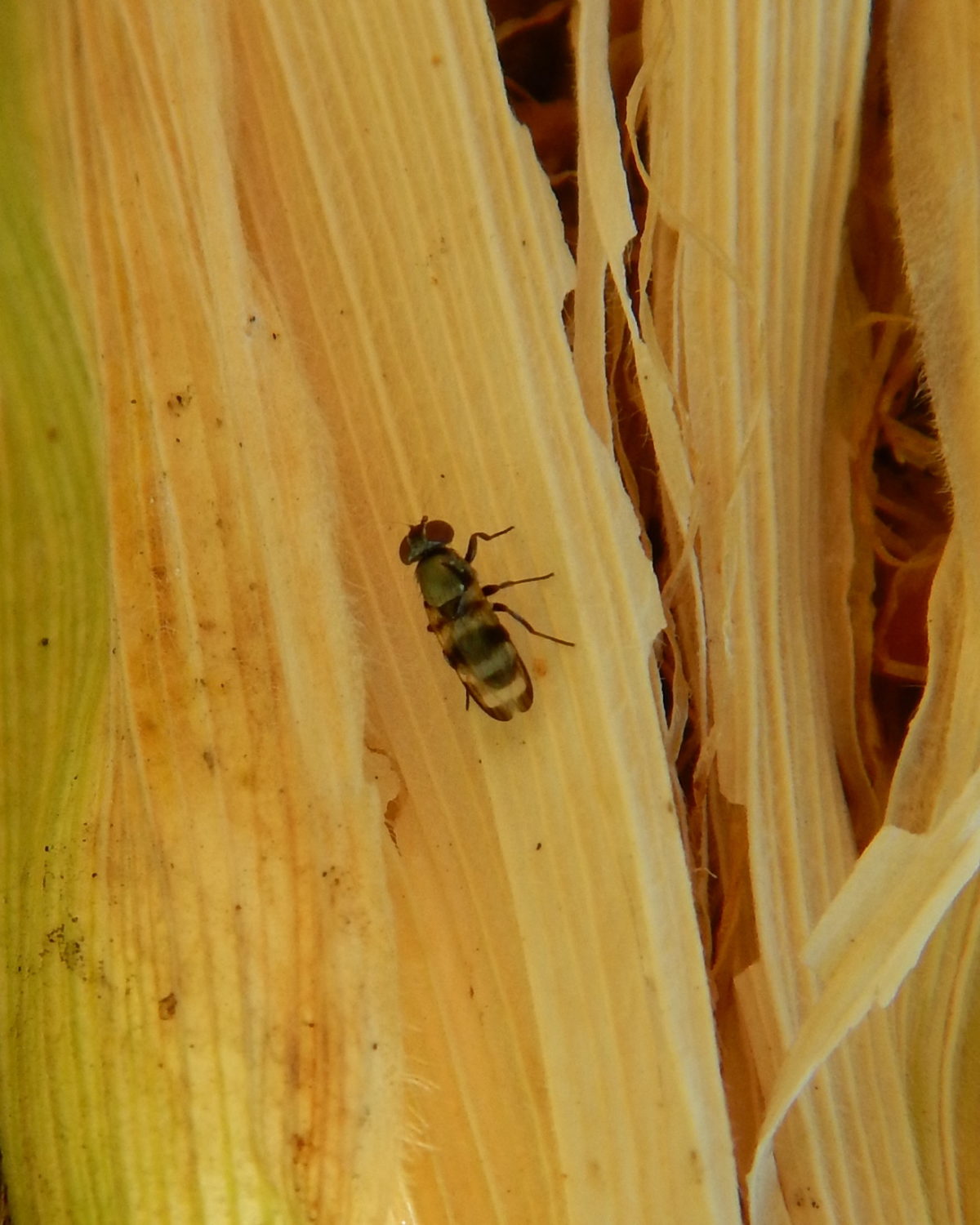By Julien Beuzelin
South Florida sweet corn growers continue to face two major insect problems: fall armyworms and corn silk flies. The two pests can be devastating, but corn silk flies are more challenging to manage than fall armyworms under current production practices.

Three silk fly species have been reported to cause the majority of the damage: Euxesta eluta, Euxesta stigmatias and Chaetopsis massyla. Silk fly adults are relatively small flies that lay eggs in silk channels. As maggots emerge from the eggs, they feed on sweet corn silks and kernels. Thus, the damaging stage of silk flies are the maggots. Maggots are legless and whitish to yellow larvae with two black dots resembling eyes on one end of the larvae. However, those dots are spiracles, which are openings that allow breathing.
Silk fly maggots infesting sweet corn ears are protected from insecticides, and management focuses on the adults from first silk until harvest. Frequent applications of pyrethroid insecticides, sometimes daily, are the standard management tactic. Applications are triggered when field scouts detect adults in the field. However, unacceptable crop losses can still occur when silk flies are managed aggressively. In addition, intensive use of a single insecticide mode of action may lead to the development of insecticide resistance. A more efficient and diversified approach to insecticidal control is therefore needed.
SPECIES IDENTIFICATION IS IMPORTANT
Recent research conducted at the University
of Florida Institute of Food and Agricultural Sciences (UF/IFAS) Everglades
Research and Education Center in Belle Glade has shown that the addition of
PBO, a registered insecticide synergist, to the spray solution improves
pyrethroid efficacy. It was also determined that E. stigmatias is less susceptible to pyrethroids than the other two
silk fly species, warranting more aggressive silk fly management when E. stigmatias is observed. Thus, it is important
to differentiate silk fly species when scouting.
Identification based on visual observations of adults while scouting in the field is challenging because silk flies are fast moving, and observations depend on scout expertise and numerous environmental factors. An ongoing project has determined that traps baited with ammonium acetate lures combined with the floral volatile 1,4 dimethoxybenzene capture a high number of adults of the three silk fly species in non-treated fields.
In addition, “multilure” traps that have been used for fly pests in other systems capture more silk flies than green/yellow/white “universal moth” traps. Experiments have been initiated this spring to determine the relationship between silk fly trap captures and silk fly infestations in the field. This project has the potential to assist in developing a new, streamlined monitoring tool that will improve silk fly management.
INSECTICIDE OPTIONS
Recent field evaluations have shown that
repeated applications of spinetoram effectively control silk flies. Spinetoram,
a reduced-risk insecticide with a different mode of action than pyrethroids, also
controls fall armyworms but is relatively expensive. Although spinetoram
represents an alternative to pyrethroids, cost would have to be decreased to
make it a viable silk fly management option for Florida sweet corn producers.

Field studies combining low rates of spinosad, an insecticide comparable to spinetoram, with baits attractive to silk flies will be conducted this year to determine if cost can be reduced while maintaining efficacy. Abamectin is an insecticide with another mode of action that has provided suppression of silk flies in a recent field evaluation. Thus, co-applications with pyrethroids should be considered within label restrictions.
CULTURAL PRACTICES
Although insecticides remain the main
tactic for silk fly management, cultural practices can help. Weeds within and
around sweet corn fields should be controlled, if possible, to decrease shelter
available to silk fly adults. In addition, plowing or disking sweet corn
harvest residue has reduced the number of silk fly adults emerging from the
field. However, the effectiveness of residue incorporation or destruction has
been inconsistent in field studies and is likely dependent on soil moisture.
These observations are supported by laboratory experiments showing that burying E. eluta 3 and 4 inches deep vs. 1 inch deep into organic soil typical of the Everglades Agricultural Area decreases adult emergence by 53 and 60 percent, respectively. In addition, flooding of pupae placed 1 inch deep for 48 and 96 hours decreases adult emergence by 40 and 70 percent, respectively.
CONCLUSION
Progress toward improved corn silk management in South Florida sweet corn has
recently been made. However, successful management under current production
practices only relies on a limited number of options. Ongoing research led by
UF/IFAS entomologists aims to develop additional pest management tactics for
greater sustainability of sweet corn production.
Acknowledgment: This research is partially supported by Florida Department of Agriculture and Consumer Services Specialty Crop Block Grants.
Julien Beuzelin is an assistant professor at the UF/IFAS Everglades Research and Education Center in Belle Glade.
This article was featured in the May issue of VSCNews magazine. To receive future issues of VSCNews magazine, click here.
Share this Post










